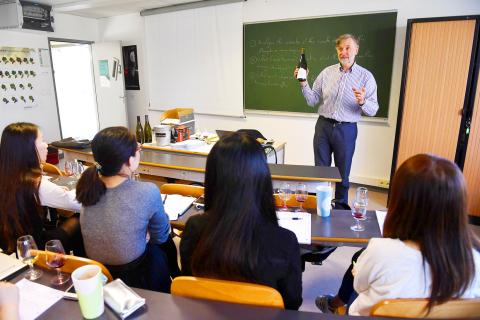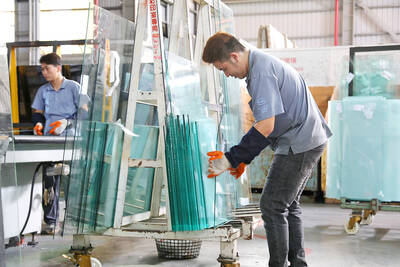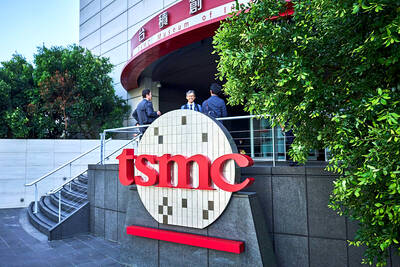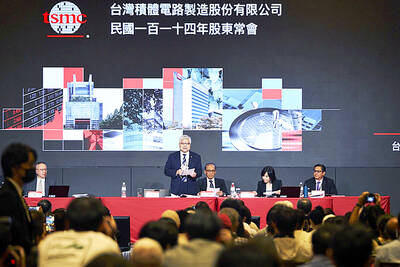Chen Yanfen swirls a glass of Burgundy wine, noting its ruby red robe and fruity bouquet before taking her first sip.
She is part of a group of Chinese students diligently imbibing the secrets of winemaking in the rolling hills of the central French region.
Nearly one-third of the Dijon wine school’s 135 students are Chinese, willing to pay up to 13,000 euros (US$14,000) for the coveted expertise.

Photo: AFP
“For most Chinese consumers, French wine is the best, because it has a long history and it is very famous in the world,” Chen, 30, said.
Like many of her peers at the School of Wine and Spirits Business, she wants to sell French and other foreign wines in China after she finishes the one-year course.
Wine glass and pen and paper in hand, the students start earning their viticulture stripes, mastering tasting terms in English.
They also study marketing, with a special emphasis on doing business in China.
While China has grown into a prolific buyer of wine, the country has also set its sights on making its own.
Last year, China produced about 11.5 million hectoliters of wine and ranked as the sixth-largest producer in the world, according to the International Organization of Vine and Wine.
For Chinese wine enthusiasts, certification in French oenology translates into considerable cachet back home when they find work in the country’s nascent wine industry.
“In China, wine is more like a luxury product. When I tell my friends I’m majoring in wine management, they say: ‘Wow, that’s cool,’” Liu Xinyang, 22, said.
“I think it’s a well-respected profession and it’s not hard to find a job with this diploma,” she said.
As China’s middle class has grown and developed a taste for fine wine, France has seen its exports to the country surge — they rose by 12.7 percent last year.
At the same time, Chinese investors are snapping up French vineyards, with Chinese tycoons owning more than 100 properties in Bordeaux, the famous wine-producing region of southwest France.
Last year alone, billionaire Jack Ma (馬雲), founder of e-commerce giant Alibaba Group Holding Ltd (阿里巴巴), bought three vineyards in the region, along with their 18th-century chateaux.
“Wine from Bordeaux is a best-seller in China, especially, good-quality red wine in the lower price range,” said Yang Tingting, a lecturer at China’s Wine and Spirit Education Trust, a wine-and-spirits professional academy in Beijing.
As a high-status product, image and branding are as important as taste, said Wei Wei, who owns a wine shop in the capital.
“Wine with a better and more delicate packaging is popular, as many Chinese buy wine to give others as a gift,” she said.
Expensive reds from Bordeaux, such as Chateau Lafite Rothschild and Chateau Mouton Rothschild, remain the most coveted in China, Wei says.
Demand is driven by wealthy people’s thirst for luxury.
Both wines are among a select list of France’s premier cru, a label established by Napoleon III in 1855 to classify the country’s most prestigious wines. A single bottle can cost between 800 and 2,000 euros.
Burgundy is not far behind in the popularity contest, emerging as a strong rival to Bordeaux in the Chinese market.
Nestled in its picture-postcard hills is a narrow 60km stretch of land where no fewer than 1,000 “climats” — areas with distinct geological and weather conditions — coexist.
“Burgundy is a pretty good standard-bearer” for quality French wine, School of Wine and Spirits Business director Jerome Gallo said.
The school has had to turn away some Chinese applicants to maintain balance in the student body — and because it wants networking to take place between Asian and European students.
However, Chinese students are welcomed as both customers and promoters of French wine.
“What we want is not just for them to sell our wine, but to go home with a piece of this school, a piece of Burgundy and a piece of France in their hearts,” Gallo said.
Steve Charters, a British-Australian teacher at the school, said the know-how the students acquire will start them on the road to excellence, but it will be a long journey.
“It’s taken France 2,500 years to work out its best terroirs, or prime winegrowing parcels, its best sites and how to make the wine,” Charters said.
However, he added the Chinese students were fast learners, with the ability to bring their own perspective to the table.
“Because they don’t have a long-standing culture of wine consumption, they’re more open-minded. They love Bordeaux, they love Burgundy, that’s absolutely true, but it’s easier for them to say: ‘Ah, yes, but Chile makes good wine, or South Africa makes good wine,’” he added.
So far, the market for French and other foreign wines is small: About 80 percent of Chinese consumers drink wine made in China.

CAUTIOUS RECOVERY: While the manufacturing sector returned to growth amid the US-China trade truce, firms remain wary as uncertainty clouds the outlook, the CIER said The local manufacturing sector returned to expansion last month, as the official purchasing managers’ index (PMI) rose 2.1 points to 51.0, driven by a temporary easing in US-China trade tensions, the Chung-Hua Institution for Economic Research (CIER, 中華經濟研究院) said yesterday. The PMI gauges the health of the manufacturing industry, with readings above 50 indicating expansion and those below 50 signaling contraction. “Firms are not as pessimistic as they were in April, but they remain far from optimistic,” CIER president Lien Hsien-ming (連賢明) said at a news conference. The full impact of US tariff decisions is unlikely to become clear until later this month

With an approval rating of just two percent, Peruvian President Dina Boluarte might be the world’s most unpopular leader, according to pollsters. Protests greeted her rise to power 29 months ago, and have marked her entire term — joined by assorted scandals, investigations, controversies and a surge in gang violence. The 63-year-old is the target of a dozen probes, including for her alleged failure to declare gifts of luxury jewels and watches, a scandal inevitably dubbed “Rolexgate.” She is also under the microscope for a two-week undeclared absence for nose surgery — which she insists was medical, not cosmetic — and is

GROWING CONCERN: Some senior Trump administration officials opposed the UAE expansion over fears that another TSMC project could jeopardize its US investment Taiwan Semiconductor Manufacturing Co (TSMC, 台積電) is evaluating building an advanced production facility in the United Arab Emirates (UAE) and has discussed the possibility with officials in US President Donald Trump’s administration, people familiar with the matter said, in a potentially major bet on the Middle East that would only come to fruition with Washington’s approval. The company has had multiple meetings in the past few months with US Special Envoy to the Middle East Steve Witkoff and officials from MGX, an influential investment vehicle overseen by the UAE president’s brother, the people said. The conversations are a continuation of talks that

CHIP DUTIES: TSMC said it voiced its concerns to Washington about tariffs, telling the US commerce department that it wants ‘fair treatment’ to protect its competitiveness Taiwan Semiconductor Manufacturing Co (TSMC, 台積電) yesterday reiterated robust business prospects for this year as strong artificial intelligence (AI) chip demand from Nvidia Corp and other customers would absorb the impacts of US tariffs. “The impact of tariffs would be indirect, as the custom tax is the importers’ responsibility, not the exporters,” TSMC chairman and chief executive officer C.C. Wei (魏哲家) said at the chipmaker’s annual shareholders’ meeting in Hsinchu City. TSMC’s business could be affected if people become reluctant to buy electronics due to inflated prices, Wei said. In addition, the chipmaker has voiced its concern to the US Department of Commerce